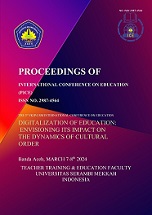The Impacts of Storytelling on Students’ Grammar Learning in SMPN 13 Banda Aceh
Main Article Content
Abstract
Teaching English grammar to middle school students in non-native contexts presents challenges, particularly when relying on traditional methods such as drills and memorization. This study investigates the impact of storytelling as an alternative instructional method for teaching English grammar, focusing on Grade 7 students at SMP 13 Negeri Banda Aceh. Drawing on the theoretical frameworks of Bruner (1996), Krashen (1982), and Schunk (2012), the research explores how storytelling influences students' understanding, engagement, and participation in grammar lessons, particularly in topics such as simple present tense, present continuous tense, and sentence structure. A mixed-methods design was employed, involving 30 students over a six-week period. Quantitative data were collected using a closed-ended questionnaire with ten yes/no questions, while qualitative insights were gathered through thematic analysis of interviews with four students. The results revealed that 93% of students found storytelling enjoyable, 90% reported better understanding, and 97% expressed a desire to continue learning grammar through stories. Interview findings supported these results, highlighting increased motivation, confidence, and participation in grammar activities. Students reported that grammar became more meaningful and easier to apply when taught through storytelling, as stories provided real-life contexts and emotional engagement. This study concludes that storytelling is an effective and engaging approach to grammar instruction, enhancing students’ comprehension and motivation. The findings suggest that incorporating storytelling into English grammar lessons can foster a more student-centered and enjoyable learning experience, offering a promising alternative to traditional grammar teaching methods in EFL classrooms.


